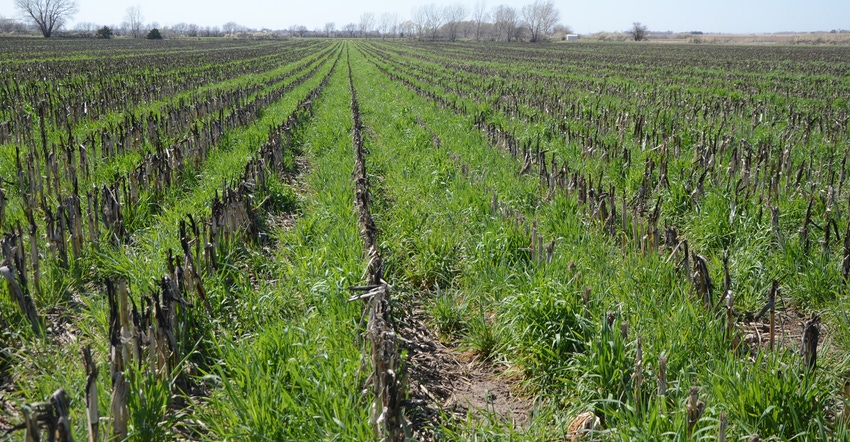
The primary focus of the Iowa Pest Resistance Management Program in Harrison County has been slowing the spread of herbicide resistance through judicious use of herbicides. However, this year, the group is evaluating some additional practices for weed suppression – specifically, cover crops.
"In our demonstration for this year, we have some cover crops planted. We have cereal rye planted at two different rates in the field. We're going to plant soybeans into rye, and evaluate that as an opportunity for weed suppression," says Mike Witt, an Iowa State Extension field agronomist and member of the Harrison County group. "The hardest part about growing cover crops in Iowa is getting consistent growth and consistent planting in order to get a solid weed suppression effect. Even with cover crops, you're still going to need herbicides."
Treatments include cereal rye planted at 1 bushel and 2 bushels per acre, planted in strips last fall in Harrison County. Both were terminated before soybeans were planted in the rye stubble this spring. Later this season, the group will evaluate how effective the treatments are for weed suppression.
Larry Buss, a Harrison County Master Farmer who's a member of the group, has been planting cover crops on various fields since 2014. He notes most growers in the area who plant cover crops plant them for erosion control. With Iowa's shorter window for establishment, it can be difficult to get adequate growth from cover crops for weed control.
"I plant cover crops on hill ground into soybean stubble, going to corn the next year, because I want additional erosion control. Sometimes I don't get them planted until mid-October; and it seems like the last few years, we get a cold snap around the first of November and it shuts their growth down. Then I don't get a lot of growth until springtime. So, I don't see many people locally planting cover crops for weed control," Buss says. "That's why we're growing cover crops in our plot this year – so we can start providing some data on the value of cover crops to suppress weeds."
When to seed cover crops
Buss seeds cover crops after soybeans, because soybean stubble leaves less residue to protect the soil compared to cornstalks. However, he notes if cereal rye isn't terminated early enough, it can also tie up nitrogen that won't be available to the following corn crop until later in the season. Later termination can also result in allelopathy issues in corn, which is why many growers seed cereal rye after corn rather than before. However, later termination also results in greater biomass growth, meaning more weed suppression and improved erosion control.
"In these Loess Hills, when most people try growing cover crops, it is to help them reduce erosion they may be seeing with just a pure no-till program," Buss adds. "With more herbicide resistance developing, to save these Loess Hills from being tilled, I could see myself and others planting cover crops into cornstalks going into soybeans if we think it will help combat these resistant weeds, because we don't want to go back to tillage."
That's especially important in the Loess Hills, where no-till is paramount to reducing soil erosion. Cover crops add another layer of protection from erosion, in addition to potential benefits from weed suppression. And cover crops may be necessary for those reverting back to tillage for weed control.
"Here in Harrison County, we've got two worlds. We've got the Loess Hills. They're very fragile, and very erosion-prone. Then we've got our flatlands, and most of them are river bottom," Buss says. "We can go back to tillage on those flatlands if we need to combat resistant weeds. But for us to go back to tillage in these Loess Hills will negate all of the good things that have happened with no-till over the years. These hills, because of no-till, can raise the same or better crops than you can in flat country. If we don't beat herbicide resistance, I hate to think we might have to go back to tillage."
About the Author(s)
You May Also Like






